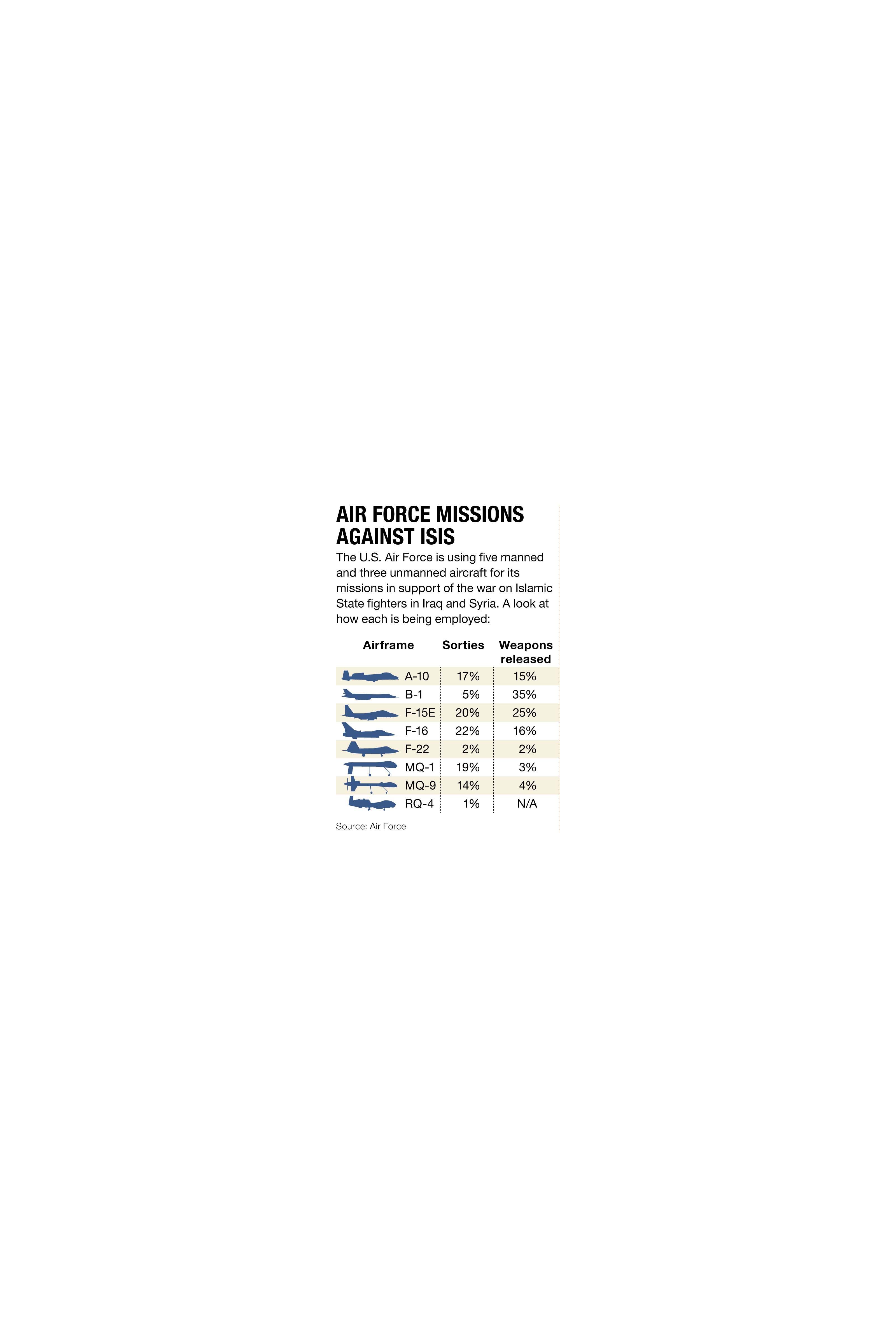Nearly one in five of the Air Force's remotely piloted aircraft missions against the Islamic State involves strikes against the militants, according to Air Forces Central Command.
Unmanned aircraft leave the Islamic State nowhere to hide. Unmanned aircraft MQ-1 Predators and MQ-9 Reapers, armed with Hellfire missiles, have flown a third of the Air Force's sorties against Islamic State militants since the start of Operation Inherent Resolve, providing intelligence, reconnaissance and surveillance. The unmanned aircraft have hit ISIS targets on 17 percent of those sorties, Between intelligence, reconnaissance and surveillance and targeted strikes, Air Force RPAs have flown 33 percent of sorties since the start of Operation Inherent Resolve, according to statistics from Air Forces Central Command AFCENT statistics provided to Air Force Times.
About 17 percent, nearly one in five, Nearly one in five (17 percent) of the service's remotely piloted missions over Iraq and Syria involve targeted strikes, according to AFCENT said.
The Air Force is using the MQ-1 Predator and MQ-9 Reaper for its unmanned airstrike missions for OIR. Both RPAs are equipped to carry Hellfire missiles.
"When comparing manned vs. unmanned aircraft, it's not important where the aircrew sits to deliver the effects, it’s the effect it delivers that matters," said AFCENT spokeswoman Lt. Col. Kristi Beckman. "The MQ-1 and MQ-9 aircraft deliver persistent attack and reconnaissance and are vital compleiments to the AFCENT inventory. Both of these platforms, like our manned aircraft, bring different but indispensable qualities to the fight."
Although And MQ-1s are nearing the end of their service life, they are now flying just as often as F-15Es before their time runs out.
The phased retirement of the Predator is set begin to be phased out for retirement starting later this year;, and all MQ-1s are expected planned to be out of service by 2018-2019, officials have said. The Air Force wants to move its airmen onto more MQ-9s and has requested 24 more Reapers in its fiscal 2017 budget.
"The 12 MQ-9 aircraft added in FY15 and the addition of 4 more aircraft in FY16 will greatly aid our combat and reconnaissance operations we provide to the Ccombatant Ccommanders," Gen. Herbert "Hawk" Carlisle, head of Air Combat Command, recently told Congress.
"Air Force MQ-1s and MQ-9s currently fly 60 combat lines every day. Each combat line can last up to 22 hours," he stated said in his written testimony for before the Senate Armed Services Committee hearing on March 16.
Carlisle did not specify how many combat lines were specifically being flown for missions against the Islamic State.
It is also likely that some of the missions are being flown for the CIA, but the agency declined to comment on the matter.
Here's how remotely piloted aircraft contribute to the air war against the islamic Statefit into both the manned and unmanned sortie and strike flights over ISIS territory:

The U.S. Air Force is using five manned and three unmanned aircraft for its missions in support of the war on Islamic State fighters in Iraq and Syria. A look at how each is being employed
Photo Credit: Air Force
The RQ-4 Global Hawk, which can hover for more than over 35 hours, contributes slightly just a hair to high-altitude reconnaissance missions, according to AFCENT. The all-weather, long-distance aircraft does not carry missiles or weapons, but can guide other aircraft to their targets and monitors the airstrikes.
The Air Force has been dominating the air war in Iraq and Syria since the Pentagon committed to fight the Islamic State military group, also known as ISIS or ISIL, in 2014. The service, flying more than half the total coalition sorties under OIR, has dropped 4,748 bombs so far in 2016.
Remotely piloted aircraft RPAs continue to anchor the 24/7 fight night- and day-efforts against the extremist group, now spreading its upheaval through Europe. Most recently, ISIS claimed responsibility for the bombings in Brussels, Belgium. In addition to the Air Force drones, the Army flies tactical unmanned aerial vehicles like the MQ-1C Gray Eagle for OIR operations. The Gray Eagle, which also can be armed with Hellfire missiles, also capable of being armed with Hellfires, has flown armed sorties, Army Col. Chris Garver, an OIR spokesman, told Air Force Times Tuesday. He did not say whether elaborate if the Army had actually struck any targets conducted any targeted strikes. The Navy does not have an unmanned ISR capability operating in Iraq or Syria.
The coalition's platforms are all essential, but U.S. fighter aircraft such as the F-16 (which flies the most sorties for OIR) and bombers like the B-1 (which drops the most ordnancebombs the most for OIR), still "cannot orbit unseen and unheard over a civilian population interspersed with enemy combatants," Carlisle said.
"They are limited by their loiter time and aerial refueling requirements. Our MQ-1 and MQ-9 aircraft have no such limitations," he said.
Oriana Pawlyk covers deployments, cyber, Guard/Reserve, uniforms, physical training, crime and operations in the Middle East, Europe and Pacific for Air Force Times. She was the Early Bird Brief editor in 2015. Email her at opawlyk@airforcetimes.com.





